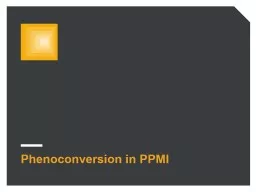

2 outline Definitions of phenoconversion Characteristics of phenoconverters Defining phenoconversion in pppmi 4 Definition of phenoconversion Datadriven Diagnostic codes biomarkers ID: 780256
Download The PPT/PDF document "Phenoconversion in PPMI" is the property of its rightful owner. Permission is granted to download and print the materials on this web site for personal, non-commercial use only, and to display it on your personal computer provided you do not modify the materials and that you retain all copyright notices contained in the materials. By downloading content from our website, you accept the terms of this agreement.
Slide1
Phenoconversion
in
PPMI
Slide22
outline
Definitions of
phenoconversion
Characteristics of
phenoconverters
Slide3Defining
phenoconversion
in
pppmi
Slide44
Definition of
phenoconversion
Data-driven
Diagnostic codes
…biomarkers…
Slide55
Data-driven
Slide66
Data-driven
Diagnostic Features Questionnaire responses:
Bradykinesia present and typical for PD (Question 7.1=1)
and at least one of the following:
Resting tremor present and typical for PD
(Question 5.1=1)
Rigidity present and typical for PD
(Question 6.1=1)
Postural/gait disturbances present and typical for PD (Question 8.1=1)
Slide77
Diagnostic codes
RBD=23
Hyposmia
=23
Slide88
Diagnostic codes
Asymptomatic genetic=17
Slide99
Diagnostic codes
Slide1010
Diagnostic codes
Slide1111
Diagnostic codes
Considerations regarding code 97 (see next slide)
Slide1212
Diagnostic codes
Notes to site PIs:
“Other” (code 97) should not be used to indicate non-specific exam findings (like “tremor NOS”)
Code LRRK2-associated PD as idiopathic PD
Comorbid conditions should be listed in medical conditions log even if they are neurologic:
Multiple Sclerosis
Tremor NOS
Peripheral Neuropathy
Slide1313
Diagnostic codes
Notes to site PIs:
Be mindful of code “fluctuations”, especially once a neurodegenerative parkinsonism code is assigned
Slide1414
Biomarker-defined conversion
Future work will aim to define biomarker-based algorithms to identify
phenoconversion
including but not limited to:
Imaging
CSF
Questionnaire responses
Smell test
Exam findings
Wearable data
Slide15Characteristics of
phenoconverters
in
ppmi
Slide1616
Converters vs. nonconverters
When conversion is defined as code=24:
“Prodromal Motor PD”
or
change to a neurodegenerative parkinsonism
60 cases have “converted”
32 (53.3%) Genetic cohort
12 (20.0%) Hyposmia cohort
16 (26.7%) RBD cohort
NOTE: mean follow-up time 34.2 months in converters vs. 19.8 months in non-converters (p<0.0001)
Slide1717
Converters vs. nonconverters
Slide1818
Converters vs. nonconverters
Slide1919
Converters vs. nonconverters
Slide2020
Converters vs. nonconverters
When conversion is defined as change to a neurodegenerative parkinsonism code only:
PD, PSP, MSA, DLB, CBS, FTD
23 cases (of the 60) have “converted” to diagnosed neurodegenerative parkinsonism
5 (21.7%)
Genetic cohort
7(30.4%)
Hyposmia cohort
11(47.8%)
RBD cohort
19 PD, 3 DLB, 1 PSP
(1 PD later changed to MSA)
Slide2121
Converters vs. nonconverters
Slide2222
Converters vs. nonconverters
Slide2323
Slide2424
Slide2525
Summary
Clinical features different between converters and non-converters include age, olfactory function, neuropsychiatric and autonomic symptoms, RBD and motor abnormalities
Striatal SSBR at baseline is associated with conversion
Total CSF
α
-
syn
is not associated with conversion, though perhaps change in CSF
α
-
syn
is of predictive value
Slide26Characteristics of
phenoconverters
in the
Rbd cohort
Slide2727
RBD Converters vs. nonconverters
RBD cohort:
n=38
RBD symptom duration: mean 9.94 years (range 0.38-30.36 years)
RBD duration since diagnosis: mean 2.92 years (range 0.04-11.77)
Recruitment heavily stratified toward
DaTscan
SPECT deficit (~90%:~10%)
Slide2828
RBD Converters vs. nonconverters
RBD cohort: 11 converters vs. 27 non-converters
Mean follow-up time 40.91
mo
in converters vs. 37.33
mo
in non-converters (p=0.047)
7 converted to PD
3 to DLB
1 to MSA (first coded as PD then after 4 visits to MSA)
Slide2929
RBD Converters vs. nonconverters
Slide3030
RBD Converters vs. nonconverters
Slide3131
RBD Converters vs. nonconverters
Slide3232
Summary
Motor abnormalities are greater among converters; neuropsychiatric symptoms and autonomic symptoms worse
Even among a group selected based on
DaT
binding,
DaT
measures are strongly associated with conversion
Slide33Questions/
comments